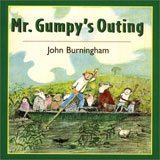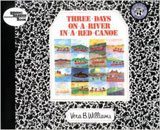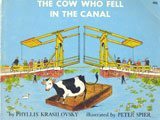by Phyllis Root and Jacqueline Briggs Martin
Summertime. And whether we live by water or only dream of living by water, reading about river adventures is fun. We are fortunate to have a number of wonderful books that take us out onto the water. We are unfortunate that only one of the books on today’s list can easily be found at a library.
We two bloggers dream of a library that does not “weed,” but keeps books on the shelves because they are timeless and will always appeal to children. Perhaps that’s what we are trying to do with this blog: create our own “library” of books that nourish wonder, grow sympathy, fill brains with possibility.
What better place to do all that than the river? Let’s shove off.
 Mr. Gumpy’s Outing, by John Burningham. Some library copies of Mr. Gumpy’s Outing look like they are one hundred years old, not merely forty-five. It is such a good story that it deserves not to be overlooked because it looks worn. Time to summon the library angels of our nature to donate new copies. As you all may know, “Mr. Gumpy owned a boat and his house was by a river.” When he goes out in his boat various characters come up to the river bank and ask to go along. He says yes to all but there are some rules. The children are not to squabble, the rabbit not to hop about, the cat not to chase the rabbit, the dog not to chase the cat, the pig not to muck about, the sheep not to bleat, the chickens not to flap (it’s hard not to list them all because the verbs are so wonderful), the calf not to trample, and the goat not to kick. For a while all goes along well, but life is life. And we know they will do what they are not to do. …So the boat tips over, but no lectures from Mr. Gumpy. That may be the best part of the book. He says, “We’ll walk home across the fields…It’s time for tea.” Mr. Gumpy knew something like this would happen. It’s in the nature of children to squabble and calves to trample. We can still drink tea and eat sweets. This book is sure to please, whether being read or acted out by young actors. It’s a joy.
Mr. Gumpy’s Outing, by John Burningham. Some library copies of Mr. Gumpy’s Outing look like they are one hundred years old, not merely forty-five. It is such a good story that it deserves not to be overlooked because it looks worn. Time to summon the library angels of our nature to donate new copies. As you all may know, “Mr. Gumpy owned a boat and his house was by a river.” When he goes out in his boat various characters come up to the river bank and ask to go along. He says yes to all but there are some rules. The children are not to squabble, the rabbit not to hop about, the cat not to chase the rabbit, the dog not to chase the cat, the pig not to muck about, the sheep not to bleat, the chickens not to flap (it’s hard not to list them all because the verbs are so wonderful), the calf not to trample, and the goat not to kick. For a while all goes along well, but life is life. And we know they will do what they are not to do. …So the boat tips over, but no lectures from Mr. Gumpy. That may be the best part of the book. He says, “We’ll walk home across the fields…It’s time for tea.” Mr. Gumpy knew something like this would happen. It’s in the nature of children to squabble and calves to trample. We can still drink tea and eat sweets. This book is sure to please, whether being read or acted out by young actors. It’s a joy.
 So is Vera B. Williams’ Three Days on a River in a Red Canoe a joy. Though this book is not available in any of three eastern Iowa libraries, an Amazon check shows it is still being purchased and loved by readers. Published in 1981, it is written as a child’s journal of a canoe trip that takes place after the narrator, walking home from school, notices a red canoe for sale. She, Sam, Mom and Aunt Rosie “pool” their money and buy the canoe. Mom and Aunt Rosie come up with a three-day trip. They buy supplies and then “drove and drove and drove and drove and drove and drove and drove and drove and drove and drove.” What child does not have that memory of a long car trip?
So is Vera B. Williams’ Three Days on a River in a Red Canoe a joy. Though this book is not available in any of three eastern Iowa libraries, an Amazon check shows it is still being purchased and loved by readers. Published in 1981, it is written as a child’s journal of a canoe trip that takes place after the narrator, walking home from school, notices a red canoe for sale. She, Sam, Mom and Aunt Rosie “pool” their money and buy the canoe. Mom and Aunt Rosie come up with a three-day trip. They buy supplies and then “drove and drove and drove and drove and drove and drove and drove and drove and drove and drove.” What child does not have that memory of a long car trip?
The book includes so much — Mom and Aunt Rosie lowering the boat over a waterfall, camp cooking, instructions on how to tie a half hitch, a recipe for pancakes and fruit stew, and dumplings, sketches of fish and fowl. It is as if we were on the trip.
The tone also contributes to the special-ness of this book. Vera B. Williams has captured the leisurely feeling of a river trip: let’s stop to swim, tell stories at night, watch a muskrat. And there’s the unspoken caring. When Sam stands up and falls out of the canoe, he gets towed to shore. “Mom doesn’t say much, but she looks upset. Aunt Rose looks scared. Sam changes to dry clothes and we canoe on.” Vera B. Williams doesn’t need to say how much Mom and Aunt Rosie love the kids. That love and caring infuses the story, as in all of Williams’s work — and that’s why we keep going back to it.
 Perhaps it’s not the same as a parent’s love for a child, but how can we not love Hendrika, the Dutch cow, envisioned by Phyllis Krasilovsky and illustrated by the wonderful Peter Spier? The Cow Who Fell in the Canal was first published in 1957. According to Krasilovsky’s obituary in the New York Times the book became so popular in the Netherlands that the author was feted by the Dutch Consul in New York. The book begins: “Hendrika was an unhappy cow. She lived on a farm in Holland, where it is very flat. All summer long she ate grass. All winter long she ate hay. All winter and all summer she did nothing but eat.” She’s learned about the city from Pieter, the horse, who comes to pick up the milk. One day while out eating grass she falls into the canal. Of course she continues eating and then stumbles upon a raft. Spier shows us the entire process of pushing and maneuvering and finally falling onto the raft. Then the adventure begins! Hendrika is the mischievous child in all of us. She runs, she tramples, she wears a straw hat and finally she goes home, where “she had so much to think about.” If this book had no words it would be wonderful because Peter Spier’s illustrations are so full of detail and energy. But the words tell us of a great adventure that left the wanderer changed — as all good adventures do, as all good books do.
Perhaps it’s not the same as a parent’s love for a child, but how can we not love Hendrika, the Dutch cow, envisioned by Phyllis Krasilovsky and illustrated by the wonderful Peter Spier? The Cow Who Fell in the Canal was first published in 1957. According to Krasilovsky’s obituary in the New York Times the book became so popular in the Netherlands that the author was feted by the Dutch Consul in New York. The book begins: “Hendrika was an unhappy cow. She lived on a farm in Holland, where it is very flat. All summer long she ate grass. All winter long she ate hay. All winter and all summer she did nothing but eat.” She’s learned about the city from Pieter, the horse, who comes to pick up the milk. One day while out eating grass she falls into the canal. Of course she continues eating and then stumbles upon a raft. Spier shows us the entire process of pushing and maneuvering and finally falling onto the raft. Then the adventure begins! Hendrika is the mischievous child in all of us. She runs, she tramples, she wears a straw hat and finally she goes home, where “she had so much to think about.” If this book had no words it would be wonderful because Peter Spier’s illustrations are so full of detail and energy. But the words tell us of a great adventure that left the wanderer changed — as all good adventures do, as all good books do.
Other river picture books:
Give Her the River, by Michael Dennis Browne illus by Wendell Minor. Atheneum, 2004. A father’s thoughts about his daughter.
River Friendly, River Wild, by Jane Kurtz, illustrated by Neil Brennan. Aladdin Reprint, 2007. A story inspired by the flooding of the Red River.
